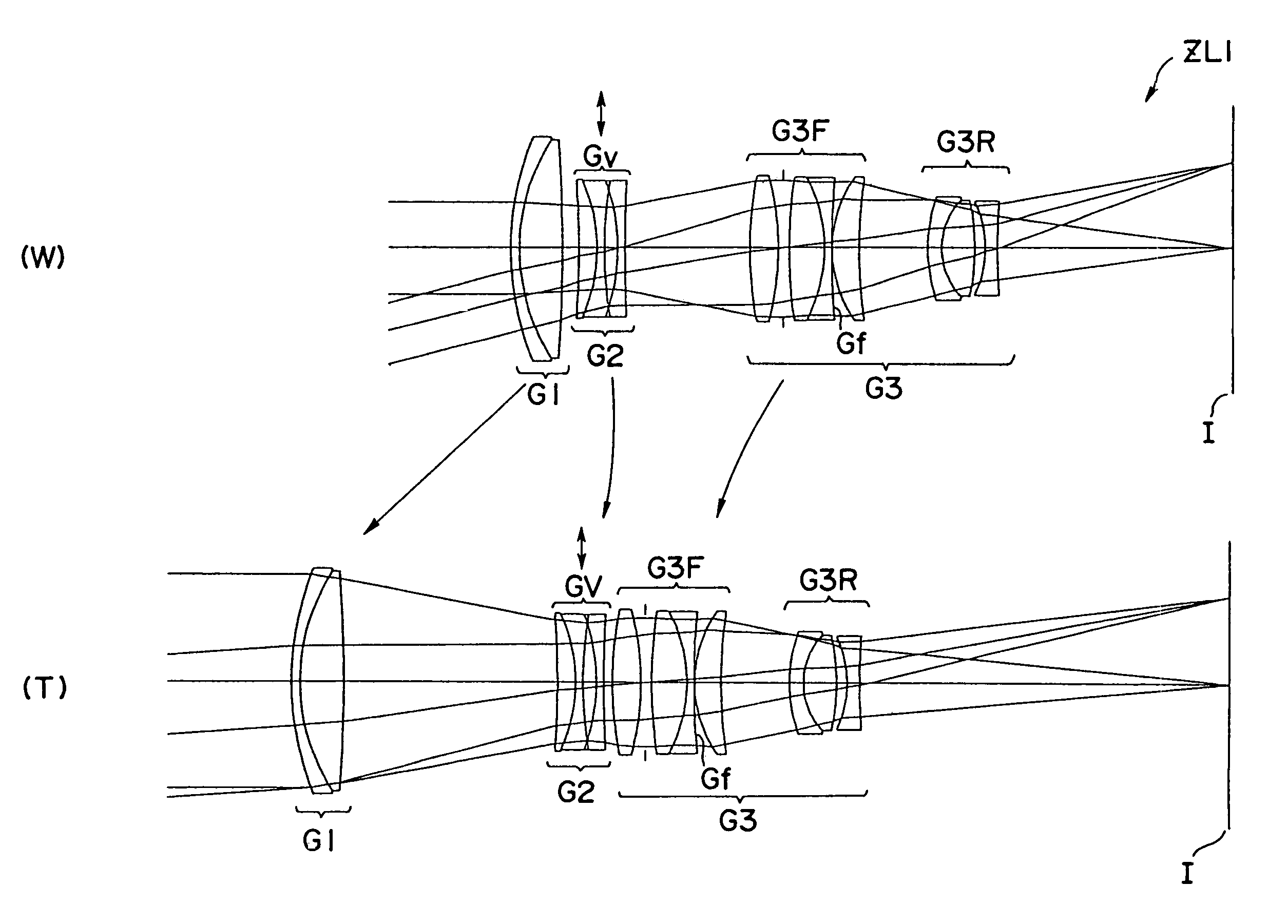Zoom lens system
a zoom lens and lens body technology, applied in the field of zoom lens systems, can solve the problems of difficult to satisfy the high optical performance (in particular, color drift) and compactness with a simple mechanism, and achieve the effect of superb optical performance and compactness
- Summary
- Abstract
- Description
- Claims
- Application Information
AI Technical Summary
Benefits of technology
Problems solved by technology
Method used
Image
Examples
example 1
[0068]Example 1 of the present invention is explained below with reference to FIGS. 1 through 4. FIG. 1 is a diagram showing lens construction of a zoom lens system according to Example 1 of the present invention. In a zoom lens system ZL1 used in Example 1, as shown in FIG. 1, a first lens group G1 having positive refractive power is composed of, in order from an object, a cemented lens constructed by a negative meniscus lens L1 having a convex surface facing to the object cemented with a double convex lens L2. A second lens group G2 having negative refractive power is composed of, in order from the object, a cemented lens constructed by a positive meniscus lens L3 having a convex surface facing to an image cemented with a double concave lens L4 and a double concave lens L5. A third lens group G3 having positive refractive power is composed of, in order from the object, a double convex lens L6, an aperture stop S, a cemented lens constructed by a double convex lens L7 cemented with...
example 2
[0077]Example 2 of the present invention is explained below with reference to FIGS. 5 through 8. FIG. 5 is a diagram showing lens construction of a zoom lens system according to Example 2 of the present invention. In a zoom lens system ZL2 used in Example 2, as shown in FIG. 5, a first lens group G1 having positive refractive power is composed of, in order from an object, a cemented lens constructed by a negative meniscus lens L1 having a convex surface facing to the object cemented with a double convex lens L2 and a negative meniscus lens L3 having a convex surface facing to the object. A second lens group G2 having negative refractive power is composed of, in order from the object, a cemented lens constructed by a positive meniscus lens L4 having a convex surface facing to an image cemented with a double concave lens L5 and a double concave lens L6. A third lens group G3 having positive refractive power is composed of, in order from the object, a double convex lens L7, an aperture...
example 3
[0084]Example 3 of the present invention is explained below with reference to FIGS. 9 through 12. FIG. 9 is a diagram showing lens construction of a zoom lens system according to Example 3 of the present invention. In a zoom lens system ZL3 used in Example 3, as shown in FIG. 9, a first lens group G1 having positive refractive power is composed of, in order from an object, a cemented lens constructed by a negative meniscus lens L1 having a convex surface facing to the object cemented with a double convex lens L2. A second lens group G2 having negative refractive power is composed of, in order from the object, a cemented lens constructed by a positive meniscus lens L3 having a convex surface facing to an image cemented with a double concave lens L4 and a double concave lens L5. A third lens group G3 having positive refractive power is composed of, in order from the object, a double convex lens L6, an aperture stop S, a cemented lens constructed by a double convex lens L7 cemented wit...
PUM
 Login to View More
Login to View More Abstract
Description
Claims
Application Information
 Login to View More
Login to View More - R&D
- Intellectual Property
- Life Sciences
- Materials
- Tech Scout
- Unparalleled Data Quality
- Higher Quality Content
- 60% Fewer Hallucinations
Browse by: Latest US Patents, China's latest patents, Technical Efficacy Thesaurus, Application Domain, Technology Topic, Popular Technical Reports.
© 2025 PatSnap. All rights reserved.Legal|Privacy policy|Modern Slavery Act Transparency Statement|Sitemap|About US| Contact US: help@patsnap.com



